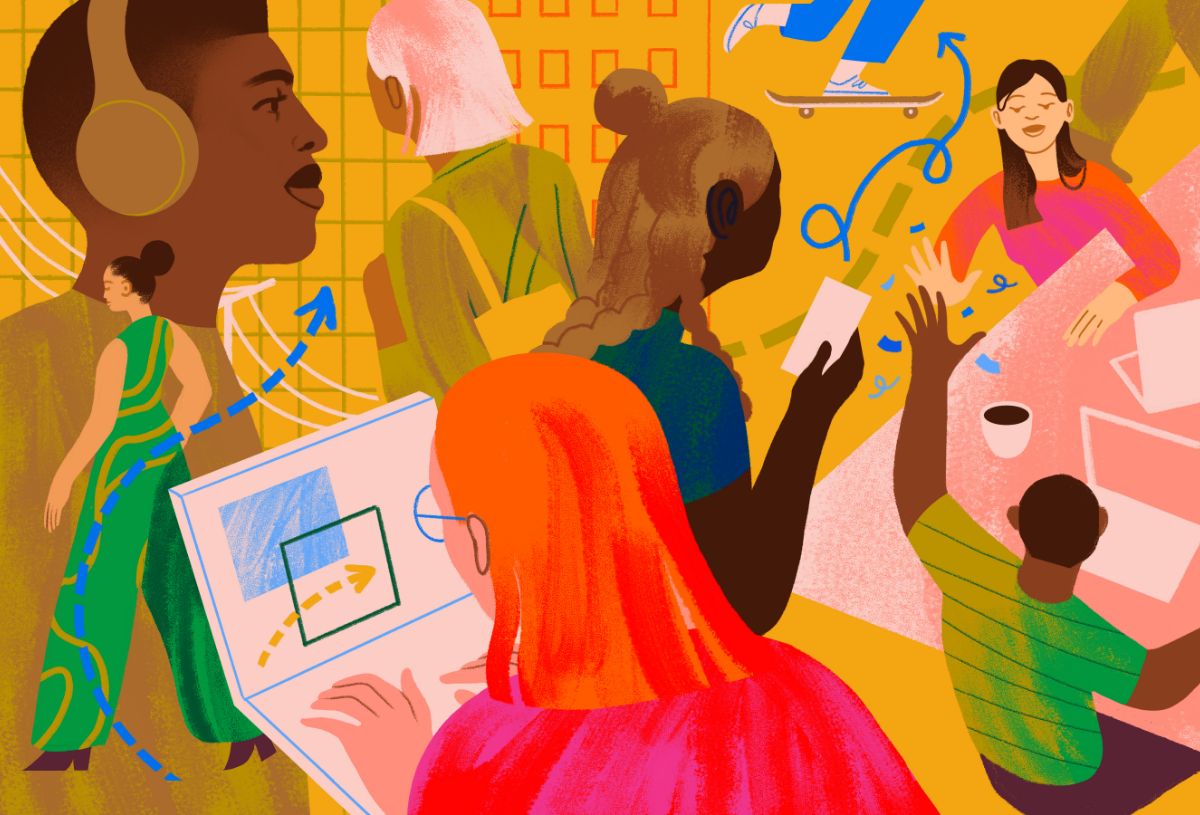10 Examples of Employee Recognition Programs From Thriving Workplaces

Updated on
March 18, 2025
18
March
2025
In times of great uncertainty and high turnover, companies need to build a strong company culture to improve employee retention and attract top talent. Consistent employee appreciation and recognition are some of the best tools to build a strong company culture.
Our Global Culture Report research shows when employees feel recognized and appreciated at work, there is an 18x increase in the probability of great work. And, employees who develop strong connections at work are 11x more likely to stay with their organization for another year (and 3x more likely to stay three more years).

Building a best-in-class recognition program doesn’t have to be impossible. At O.C. Tanner, we have been in the employee recognition industry for nearly 100 years and have helped implement and grow numerous employee recognition programs for large companies across the globe.
By incorporating a few key elements, companies can create effective, meaningful recognition programs that help employees feel appreciated, connected, and want to stay.
Here are ten companies that built thriving cultures by breathing new life into their employee recognition programs. Read about these employee recognition program examples to learn the secrets to their success.
1. Make recognition an experience
CIBC, a leading financial institution, has added employee recognition to every employee experience from onboarding to daily successes and career milestones. The company consistently goes above and beyond with creating meaningful moments for employees whenever possible.
At onboarding, new employees receive a custom backpack and pin highlighting CIBC’s purpose: “To help make your ambition a reality.” This is a great introduction to CIBC’s company culture and investment in recognition.

For daily employee recognition, all employees can access CIBC’s online employee recognition program, MomentMakers. From award nominations to notes of thanks, employees and leaders can share appreciation across the organization and accrue points for special items in the Award Store, powered by O.C. Tanner's Culture Cloud.

To celebrate career milestones, CIBC employees contribute personal notes to printed and digital Yearbooks given at each major work anniversary.

Throughout these unique recognition experiences, CIBC’s values and mission are front and center. “We can take the most important element of our culture—our purpose—and have it visible throughout,” explains Jackie Goldman, Senior Vice President, Rewards, Recognition & Performance.
However, no recognition experience is complete without employee feedback. “Employees know that they own this program. It belongs to them. It’s not owned by HR,” says Joanne Ormestad, Senior Director Recognition and Performance Enablement.
Her team continues to enhance and change recognition based on employee feedback to make MomentMakers even better for CIBC.
2. Create a flexible program that grows with your company
ICF is a highly innovative organization—so only a highly innovative recognition program would work for them.
ICF’s employee recognition program, powered by O.C. Tanner's Culture Cloud, needed to evolve to encourage usage and meet new employee needs. Now, ICF employees can access their recognition program with the tools they use every day, making recognition accessible, easy to use, and top of mind.

With these scalable improvements, ICF has seen impressive usage results:
- 90% of employees were recognized in one year (which equates to over 46,000 recognition moments)
- 88% of employees are using the program to recognize
- Recognition eCard use increased by 57%
As new employees join and the organization grows, employee recognition is how ICF embeds company values, culture, and feelings of belonging and inclusion to its 9,000+ employee population.
“It’s always an important thing for people to feel recognized and have a sense of connection, but even more now with a lot of people being remote. I think programs like this are especially important for people to build connections and feel appreciated.”
—Lindsay Landry, Employee Experience Lead
3. Base your recognition program around your company values
Recognition should be given when employees demonstrate what’s important to the company. This was a key strategy for IAG (Insurance Australia Group) when the company set out to transform their culture, values, and purpose with their 12,000 employees.
Supported by O.C. Tanner, IAG used its redesigned employee recognition platform to encourage leaders and employees to embed these new company values into their daily behaviors.
IAG’s HEART values—Honest and upfront, Easier together, Act and own it, Reimagine today, and Treat everyone fairly—are present in every part of their recognition program.
- Recognition eCards are called “Heartfelt Thanks” to drive key messages related to purpose, values, achievements, and behaviors.
- Reward points are called “Beats” (linking to their HEART values) that could be used to redeem items in an Award Store.
IAG has built strong momentum around creating a sustainable culture of appreciation that has played a lead role in embedding their mindset, values and behaviors. Within 14 months of relaunching their platform, 100% of employees had received some form of employee recognition, and 90% of managers had submitted recognition through the program.
A flexible employee recognition solution, like O.C. Tanner's Culture Cloud, provides a variety of tools to recognize, ensuring there’s always a meaningful and effective way to say thanks.
4. Build connections with employee recognition
In an industry where employees are on land or in the air, it may seem hard to find a way to connect with peers and leaders. American Airlines uses employee recognition to bridge this gap between its 100,000 team members.
Nonstop Thanks, American Airlines’ employee recognition platform powered by Culture Cloud, launched in 2019. It’s an easy-to-use platform that gives every team member the opportunity to recognize their peers and gives the team flexibility to add recognition for additional types of achievements.
This online and mobile employee recognition platform allows flight attendants and other team members to share recognition immediately. Nonstop Thanks helped American Airlines stay committed to their team members through the darkest days of the pandemic.
Recognition will continue to play an important role in unifying employees and strengthening the company’s culture of caring.
“We want to recognize when a crew or flight attendant does something extraordinary: helping someone with their children, returning a lost item, pushing a wheelchair to their next gate… the kind of ownership that has built the great brand that we have.”
—Claire Madden, Senior Base Manager, Flight Service Base Operations (Chicago O’Hare)

5. Center your entire culture around recognition
Ohio Living set itself apart by centering their entire workplace culture around recognizing and appreciating their employees.
They make their people-oriented culture a number one priority—so much so, that every new employee’s first day is dedicated solely to introducing them to it. The organization knows that when they put their people first, their people put their patients first.
Thanks to their investment recognition and culture, Ohio Living was able to lower infection rates, readmission rates, and improve patient outcomes, nursing satisfaction, and nursing turnover.
“By having effective recognition solutions in place, we are able to encourage people to align with our mission while demonstrating their own unique work ethic and passion.”
—Dana Ullom-Vucelich, Chief Human Resources & Ethics Officer at Ohio Living
6. Make every recognition reward personal
Recognition awards should be meaningful—and personal. BHP, a leading mining company, realized this when they needed to provide awards and recognition to over 37,000 employees spread over multiple locations across the globe.
Employee careers and retirement are recognized through BHP’s service award program, which includes a custom Yearbook and beautifully crafted custom pins. These pins have stories behind them that represent significant aspects of BHP’s history and identity—where they’ve come from, connection to growth, and where they’re headed.
From the trucks they use every day to the tools invented by BHP employees, the symbols, and their stories, really resonate with employees. “Everyone gets a hard hat saying welcome to BHP, so they really feel connected to our business from day one,” says Kirrily Lansdown, Head of Global Award at BHP.

Learn how you can use custom symbolic awards to drive a successful employee recognition program.
7. Reach every employee with recognition
Recognition efforts need to reach every employee for peak impact. 3M wanted to bring its global approach to business to its recognition program—and make sure that each employee had the opportunity to give and receive recognition no matter their location or their access to a mobile device or computer.
Their solution? Everyday Wins. It's their global peer-to-peer recognition program built on a foundation of equitable, accessible recognition. Within Everyday Wins, team leaders can build out Initiatives that connect business goals with meaningful recognition.
Whether it's a recognition eCard sent from one employee to another, or a team award for achieving a safety goal, recognition at 3M connects every employee to their teammates and the company's vision and values.
After the launch of their unified recognition program, 94% of their 93,000 employees have used the system. And in only one year, 3M employees experienced nearly 2 million recognition moments.
8. Offer timely, immediate recognition
Our research shows there is a 71% decrease in feelings of appreciation when recognition is not given after employees make an extra effort—which means recognition’s impact diminishes the longer you wait to give it.
Employee recognition has been a longstanding part of Southwest Airlines' company culture. To make sure employee recognition is shared immediately, on land or in the sky, all employees can access, send, and receive recognition through a mobile app, which is loaded on all company issued mobile devices, or by giving physical recognition cards.

Since it is so easy to share employee recognition on the spot, Southwest Airlines has seen a 97% engagement rate on their SWAG (Southwest Airlines Gratitude) employee recognition program.
9. Build a multidirectional appreciation system
As a bank that caters to entrepreneurs, The Business Development Bank of Canada (BDC) knows a thing or two about innovative ideas. A few years ago, they took their old, top-down recognition strategy to new heights by launching a program that centered around peer-to-peer recognition.
When companies encourage peer-to-peer recognition, they experience 2X greater odds of retaining employees. BDC’s new recognition program, “Exclamat!on,” allows their colleagues spread across Canada to recognize and reward each other for great work—in both English and French.
“It’s difficult to go by someone’s office to say thank you when I’m based in Ontario and they’re based in Vancouver. This technology allows us to do that electronically. It’s one of the elements that makes us a great place to work.”
—François Lecavalier, Senior Vice President of Corporate Development
10. Champion integrated employee recognition practices
The best employee recognition program examples are from companies that have integrated and embedded recognition into their culture.
Indegene’s Aspire program does just that. Indegene uses API connections to integrate the Aspire employee recognition program throughout the company. They stream real-time recognition instantaneously on television screens in the lobbies of all their offices around the world, so clients, potential candidates, and business partners can see the great work employees are doing when they visit an Indegene office.
The recognition feed is also prominently displayed on the homepage of their Intranet along with a link to the Aspire program so employees can easily recognize at the same time and place as they access other programs for work. There’s a citation library available so managers can find examples of recognition messages they can customize for their employees.
This integration has led to an overall happiness score of 75% on Indegene’s employee survey, and a 3% increase in recognition satisfaction, even in the middle of a global pandemic.
Integrated recognition contributed to an overall happiness score of 75% at Indegene.
Revolutionize your own recognition program
Now that you’ve seen some great examples of employee recognition programs, it’s time to revolutionize yours. Use these companies’ examples of employee recognition awards, programs, and strategies to inspire your own thriving workplace culture that can help you keep your best talent.
Use this guide to start revamping your own employee recognition program, or find a partner to help.
More than 3,000 companies all over the world trust Culture Cloud by O.C. Tanner to help them attract and retain talent, strengthen teams, and build exceptional workplaces. Learn more at octanner.com.



